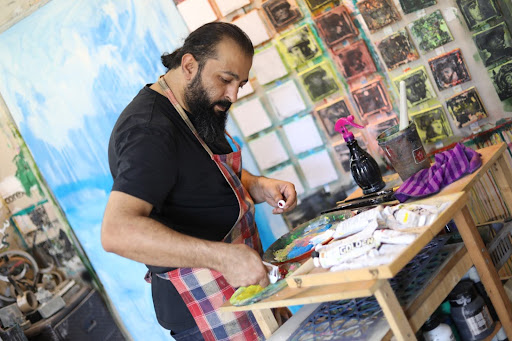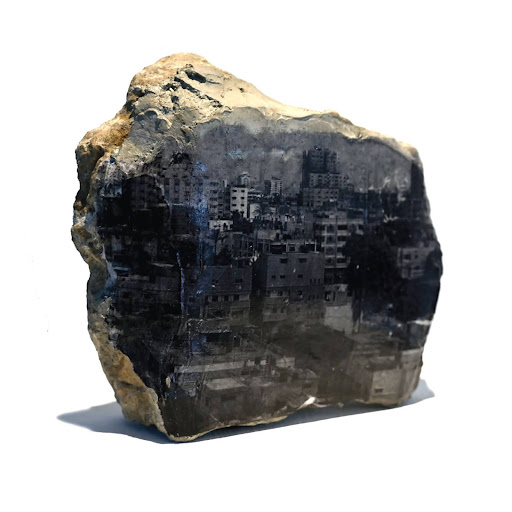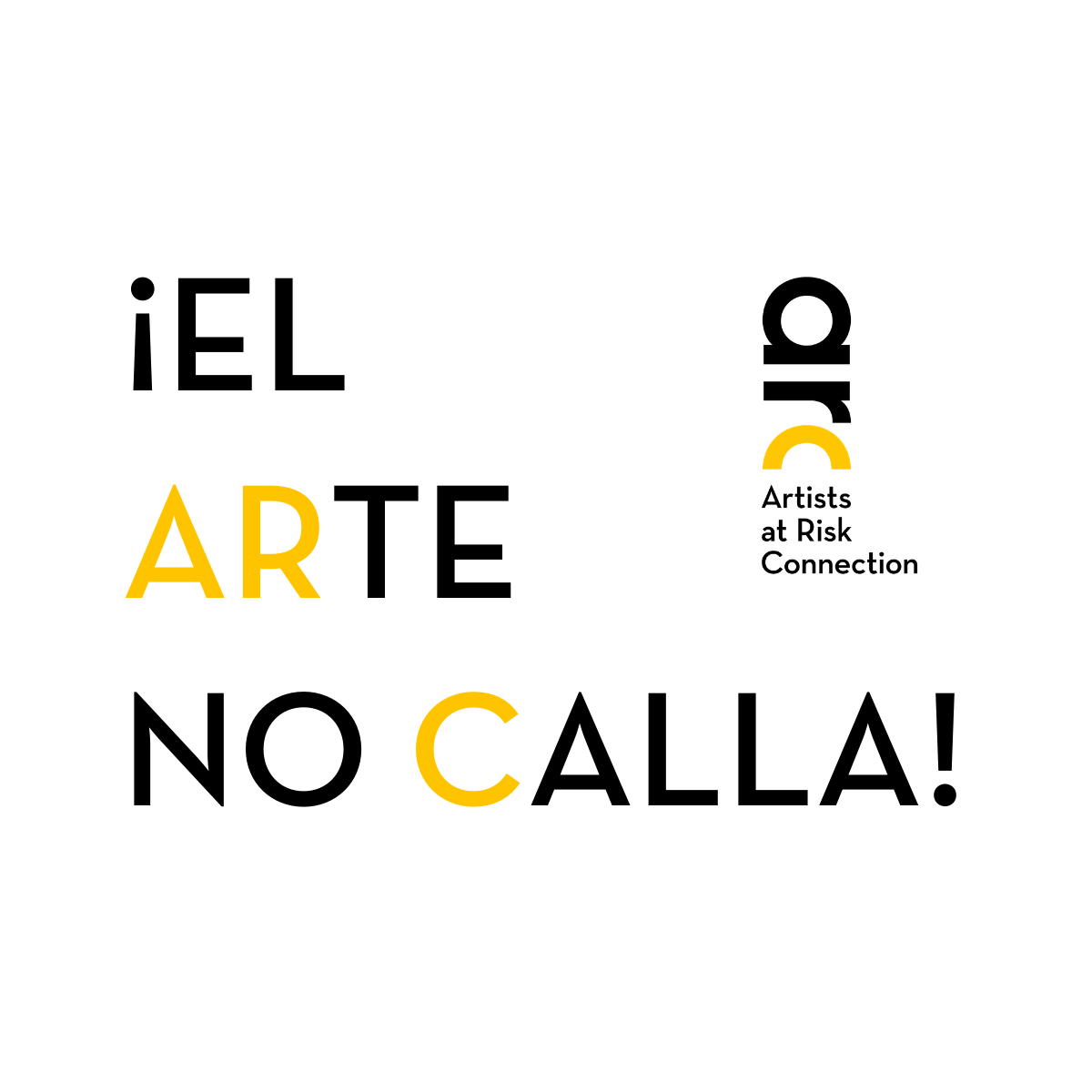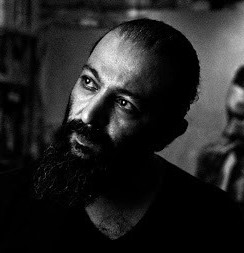Shareef Sarhan
Painter, Sculptor, Visual Artist
Palestine

Shareef Sarhan is a Palestinian artist who has worked across numerous mediums and forms. His work has been shown in Palestine in Ramallah, Bethlehem, and Jerusalem, as well as internationally in Amman, Cairo, Paris, London, the United States, Italy, and the UAE. He is a founding member of the Windows from Gaza for Contemporary Art Group (Shababek) and a member of the Association of Palestinian Artists. His belief that “art is the soft force for change” is central to the stories he tells through his work and the role that he takes on as an artist and community leader.
Expression through Art
Shareef’s artwork is the primary form wherein he expresses his identity. As a Palestinian artist who has relied on his artwork in times of war and terror, Shareef uses art to represent his community’s experiences. His identity as a Gazan artist is fundamental to his artistic approach, which combines multiple facets of Palestinian life and holds numerous truths in a single piece of artwork. Shareef is committed to this nuanced representation, and believes that his work differs from a “stereotypical image” of Gaza.
Shareef began his professional career in 1995 after graduating from the YMCA in Gaza City with a degree in Fine Arts. His perspective on contemporary art changed in 2000, after he met and collaborated with Syrian artist Marwan Qasab Bashi at the Summer Arts Academy in Amman. Bashi’s mentorship provided Shareef with an opportunity to create multimedia projects that pushed him to expand his definition of art, forming the basis for his flexibility as an artist. These experiences shaped his initial steps in his artistic journey, and instilled in him a dream to express his love for humanity. As his career progressed, he adapted a lifelong approach to preserving the memories of his people through each and every artistic medium he practiced in.
In 2003, Shareef took on one of his first major projects when he founded Windows from Gaza, an art collective formed amidst a period of Israeli siege on Gaza. The project aimed to amplify Palestinian artists and foster community during a time when Palestinians were isolated from the rest of the world. Windows From Gaza united local artists and provided the world a direct insight into their experiences. Shareef addressed both individual and collective needs by establishing a mentorship program, which connected Palestinian artists with artistic professionals outside of Gaza.

Project from the Windows from Gaza Art Collective. Courtesy of the artist.
Following the 2007 Israeli siege on Gaza City, Shareef’s approach to his art changed yet again, as his work became his primary method of communication with the outside world. Shareef tells ARC that, “in the first few years of the siege, the Israeli government prevented the entry of all raw materials and tools that help in artistic production. Therefore, we had to create alternative methods.”
“Visual projects are a transfer of the lives of the audience and their stories by using art to transform destruction and devastation into love, hope, and life.”
When the physical borders closed, Palestinian artists turned to the internet to share their artwork and stories. Amid this period of intense grief, Shareef created a project entitled “Gaza Living,” which was a series of photographs of Palestinian homes alongside images of what a peaceful future in Gaza could look like. The project encapsulated a duality that went directly against what the world was used to seeing from Gaza, a clear projection of unfiltered hope amidst devastation. Shareef describes the project as a “drawing in sunlight, those scenes give us hope and love that there will be a bright, different future for Gaza.”

Palestinian boy rollerblades past a bombed out building in Gaza.
After living through numerous sieges and periods of war, Shareef became interested in creating a project that brought attention to Palestinian children’s experiences. In 2015, his project “War Game” came together, acting as a series of examples as to how children internalize horrors and atrocities through games. The project demonstrates how children’s connection to reality is made understandable to them through the metaphor of games, where the real world is transformed into the imaginary. Shareef wrote in an interview with ARC that “the game of war changes the reality of all of us.”

Toy soldiers positioned to depict invading Israeli soldiers and placed in the rubble of destroyed buildings in Gaza.
From Galleries to the Streets
In bringing these projects to life, Shareef has worked across numerous mediums. From photography in “Gaza Living,” to acrylic painting, to documentary films capturing the everyday lives of Palestinians, Shareef has used the methods readily available to him as well as unconventional forms of art.
In 2014, while he was filming a story about life on the eastern border of Gaza City, remnants of scrap and concrete took up much of the visible space on screen. This gave him the idea to use this waste in a public installation that could function as a tool for protection and unity. The installation he had in mind: a lighthouse.
He spent years collecting materials, all left over from Israeli military attacks. The lighthouse was constructed with care and detail, and became a love letter to Gaza, immortalized as a symbol of resilience. In 2016, it became the first-ever lighthouse in Gaza and became a representation of Gaza’s strength and fortitude, its beauty made possible by the very remnants of destruction. The Gaza lighthouse is the pinnacle of Shareef’s legacy as an artist, creating art that holds both hope and pain in the same moment, and unites people together through their collective witnessing.

Shareef Sarhan built a working lighthouse in Gaza’s harbour made from construction materials collected from the rubble of bombed buildings.

Shareef Sarhan's working lighthouse in Gaza’s harbour lit up at night.
Holding Memories Within Art
By working in numerous mediums, Shareef exemplifies his strength and flexibility not only as an artist, but also as a community leader. In periods when he had little to no access to his usual supplies, or when his work was destroyed, he turned to making art out of the rubble; art that existed no matter the efforts made to erase it. Through his installations, Shareef merges art with public space, devastation with hopefulness, and creativity with community.
“Those scenes give us hope and love that there will be a bright, different future for Gaza.”
When asked if he created art with a specific audience in mind, Shareef noted that “visual projects are a transfer of the lives of the audience and their stories by using art to transform destruction and devastation into love, hope, and life.” This transfer of emotion shines through in all his work, but especially in cases where his work acts as a bridge, one that unites people together.
Since October 7, 2023, over 7,000 pieces of Shareef’s artwork have been destroyed, including the Gaza lighthouse. Today, he’s working to rebuild some of his previous projects, while also creating a new one; a series of paintings imprinted upon blocks of concrete, called “Gaza Concrete.” The project is reminiscent of both his previous work and his fortitude as an artist.

Gaza skyline imaged onto concrete rubble from bombed and destroyed buildings.
Shareef’s commitment to duality, to representing more than a single facet of Palestinian life, is what distinguishes his art. At the heart of all his artwork is his faith that it will be remembered for the hope it provided and the memories it held.
Grace Vining, September 10, 2024. Grace is a summer intern for the Artists at Risk Connection’s Protection Programs. She is a junior at Bard College, where she is joint-majoring in Human Rights and English Literature. She currently lives in New York, and calls Vermont home.






